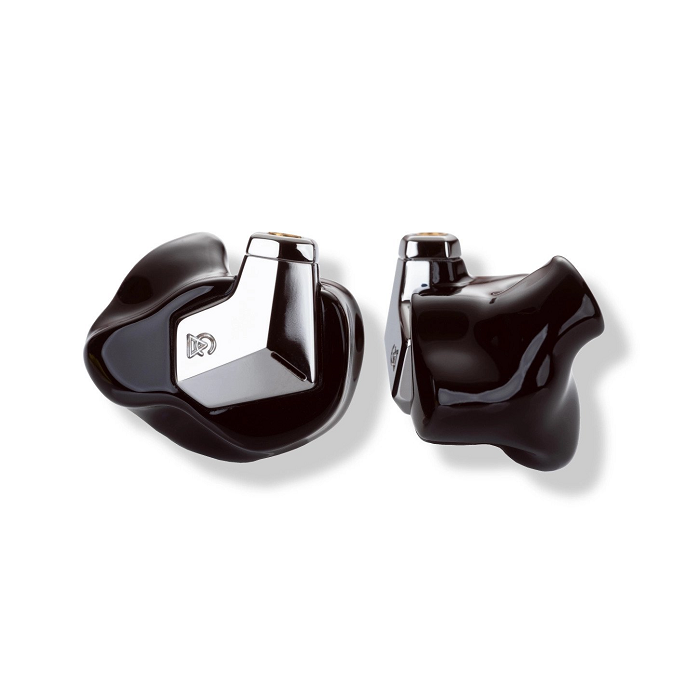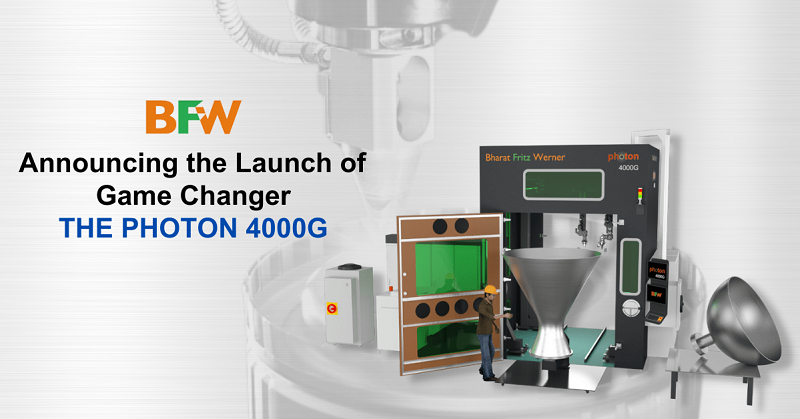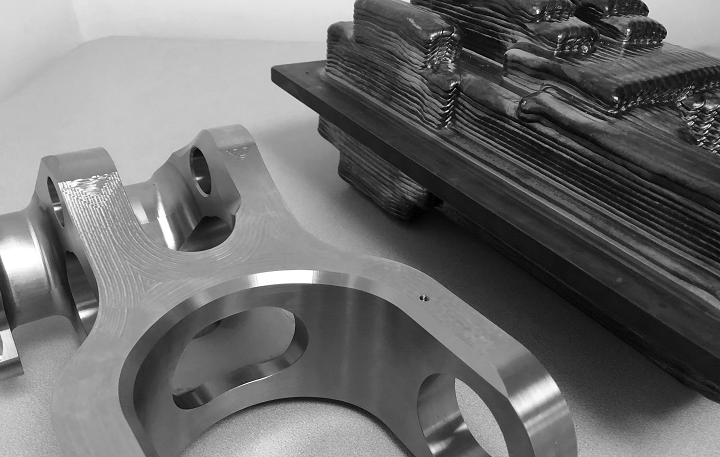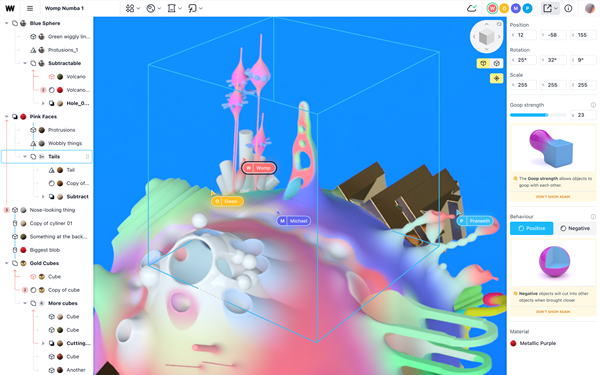Kicking off today’s 3D Printing News Briefs is a story from Campfire Audio, which is using the technology to make its new Supermoon earphones. Bharat Fritz Werner launched what it calls the world’s “largest, fastest, multi-technology laser-directed energy deposition machine,” and Norsk Titanium has completed component level testing with GA-ASI. Finally, Hyperganic acquired the physical simulation firm DirectFEM, and Womp raised $4.7 million to democratize its cloud-based 3D software.
Campfire Audio Using 3D Printing to Customize Supermoon Earphones

The Supermoon’s 3D printed solid body is hand-finished with a stainless steel faceplate. Photo courtesy of Campfire Audio.
Earphone and in-ear monitor (IEM) manufacturer Campfire Audio is using 3D printing to customize its new Supermoon IEM model. Featuring a patent-pending solid-body design and a $1,500 price tag, the IEMs offer an optimized acoustic performance, and, thanks to 3D scanning and printing, a custom fit as well. First, ear impressions are taken from the customer, and used to map the Supermoon’s interior acoustic chambers and line them up with the company’s new planar magnetic drivers, which convert electrical signals to soundwaves using a flat diaphragm for improved sound quality. The IEM is 3D printed as a single component with just a few moving parts to optimize longevity and reliability, and then it’s hand-finished with a stainless steel faceplate. The Supermoon model, which is marketed to music industry professionals and headphone enthusiasts, comes in two fits—the Artist, for everyday use and improved comfort, and the Audiophile, meant for professional musicians due to to its traditional seal depth for sonic isolation.
Caleb Rosenau, Campfire Audio’s Vice President, said, “All of our earphones are designed to create an elevated listening experience for our customers – from touring musicians and audio engineers, to music lovers who want to take their listening to the next level.
“With Supermoon, we’ve utilized our custom planar magnetic driver to achieve a new standard in audio clarity for our custom-fit offerings, and we’re pleased to invite our customers to take the leap themselves to a new plateau in the personalized audio experience.”
BFW Launches PHOTON 4000G L-DED 3D Printer
Bharat Fritz Werner Ltd (BFW), which specializes in advanced manufacturing technology platforms, just entered the metal Directed Energy Deposition (DED) industry this fall, and is already announcing the launch of the first system with its m2nxt subsidiary. BFW calls its new PHOTON 4000G laser-DED printer the metal AM industry’s “largest, fastest, multi-technology, and most commercially attractive” L-DED system in an inert, controlled atmosphere Argon chamber. This chamber measures 36 cubic meters, and the printer has a 10.4 cubic meter build envelope, along with what BFW is calling two industry-first features: dual-deposition heads on dual ram gantry for both wire and powder deposition, and a standard spec 6KW fiber laser with beam splitter for directing variable power to both print heads. Additional features include full-size front and rear doors, 5-axis control/build software, stainless steel interior, real-time process monitoring through machine vision, pyrometry, and thermography, motorized parts table, and more. The PHOTON 4000G, manufactured entirely in India, will be available starting January 2023, with a starting MSRP of €1,990,000.
“Most currently installed [DED] systems are in laboratories or light industrial applications, many are “Do It Yourself systems”, many are underpowered, undersized, or overpriced systems, many are idle or under-utilised, with few suppliers and users having the practical experience to optimally utilise this technology and reduce ‘time to value’. We believe we at BFW will be instrumental in closing the gap between supply and demand of large, very large, and huge 3D printed parts using laser-powder and laser-wire metal deposition, for free form fabrication and fine/heavy cladding/repairs,” said DED industry veteran Ashok H. Varma, EVP & Global Leader, Additive Manufacturing at BFW.
Norsk Titanium & GA-ASI Finish Full-Scale Article Testing
Metal 3D printing company Norsk Titanium US Inc. has announced the completion of successful full-scale component level testing with General Atomics Aeronautical Systems, Inc. (GA-ASI). The test program, which began last year, was part of the company’s expansion into the defense market, with Norsk Titanium US 3D printing the test component with its patented Rapid Plasma Deposition (RPD) technology. The program’s goal was to explore the use of RPD in major structural applications for GA-ASI products, and inspection, material, and functional load testing were conducted by GA-ASI additive and structural engineering teams. According to Norsk Titanium, preliminary test results for the 3D printed landing gear component were promising.
“We would like to thank GA-ASI for their support of our technology and the additive industry in general. We believe there is a good fit for our technology in GA-ASI applications that traditionally call for long lead time forgings. Our team is ready to support GA-ASI as they continue their qualification process and further develop their DED additive applications,” said Nicholas Mayer, Norsk Titanium Vice President, Commercial.
Hyperganic Announces Acquisition of Physical Simulation Firm DirectFEM
German startup Hyperganic, which is looking to disrupt CAD using generative design and AI-driven 3D printing, announced that it has acquired physical simulation software company DirectFEM, also based in Munich, for an undisclosed sum. DirectFEM’s “quasi-mesh-less” simulation solution is based on the Finite Cell Method born at TU Munich, which makes it possible to physically evaluate designs previously considered too complex to simulate. With this acquisition, Hyperganic will integrate these advanced physical simulation capabilities into its Core Algorithmic Engineering software platform, giving users the ability to directly evaluate algorithmically engineered parts and improve them before manufacturing. DirectFEM staff, including founders Nina Korshunova, Lásló Kudela, and Davide D’Angella, will join Hyperganic as full-time employees, and together, the Hyperganic and DirectFEM teams will launch the first public iteration of the Algorithmic Engineering platform—Core 3—next month.
“At Hyperganic, we embarked on a mission to engineer physical objects and machines that approach the complexity of nature. While Hyperganic Core can create these intricate designs, evaluation and testing was always a challenge,” said Hyperganic CEO and Co-Founder Lin Kayser. “Conventional simulation tools cannot handle the amount of detail our algorithms create. When we saw what the DirectFEM team had built, it became clear that this was the missing link to integrating physics deep into Hyperganic Core. The acquisition moves us forward on our mission to tackle the great engineering challenges of our time.”
Womp Announces $4.7 Million Seed Funding Round
Finally, Womp, a collaborative cloud-based 3D creation software company founded in 2019, has announced a $4.7 million seed funding round, which will be used to refine and democratize its core technology and make it easier and faster for creators to use. The round was led by Female Founders Fund and Haystack, with participation from NEO Investment Partners and several angel investors, including Director Ari Aster and A24 CEO Daniel Katz. The startup makes it possible for users to create, render, and learn from any device, as it is supposedly the only cloud-based 3D creation platform that integrates design tools with social features. Womp offers an open source, shareable format, which enables more accessibility options for designers and removes the complexity from 3D content creation. Some of its features include livestreaming, and “blend,” which lets users merge materials in real time.
“This is only the beginning of something much greater as we help pave the way for more creators to join the fascinating world of 3D design. Today’s design software comes with its share of barriers, like steep learning curves and expensive hardware required to run these programs. We’re thrilled that others recognize the work we’re doing to empower everyone to jump in and create the unimaginable,” said Womp’s CEO and Founder Gabriela Trueba.
The platform will soon be available in a private beta program to about 1,000 people, with more coming in the following months, and offers packages for business and enterprise use.
Subscribe to Our Email Newsletter
Stay up-to-date on all the latest news from the 3D printing industry and receive information and offers from third party vendors.
You May Also Like
Further Understanding of 3D Printing Design at ADDITIV Design World
ADDITIV is back once again! This time, the virtual platform for additive manufacturing will be holding the first-ever edition of ADDITIV Design World on May 23rd from 9:00 AM –...
3D Printer Maker EVO-tech Reborn as NEVO3D — Once More With Feeling
EVO-tech was a 3D printing service and original equipment manufacturer established in 2013 and based in Schörfling am Attersee, Austria. The company produced high-quality material extrusion systems featuring linear bearings,...
3D Systems Brings 3D Printed PEEK Cranial Implant to the U.S. with FDA Clearance
For more than 10 years, 3D Systems (NYSE:DDD) has worked hand-in-hand with surgeons to plan over 150,000 patient-specific cases, and develop more than two million instruments and implants from its...
CDFAM Returns to Berlin for Second Annual Symposium
The second CDFAM Computational Design Symposium is scheduled for May 7-8, 2024, in Berlin, and will convene leading experts in computational design across all scales. Building upon the first event...



































